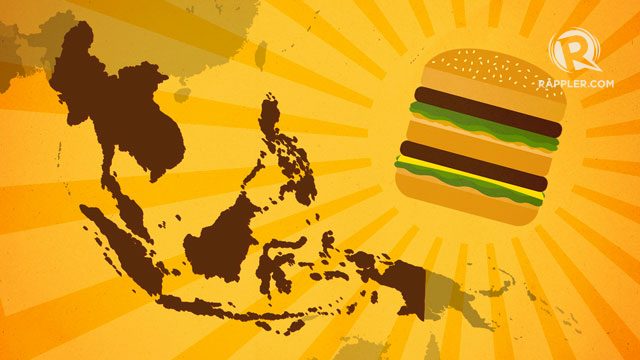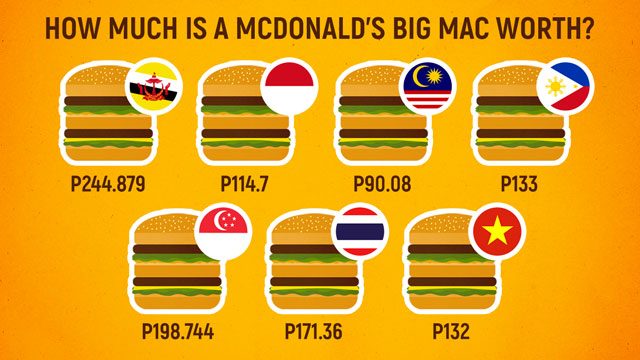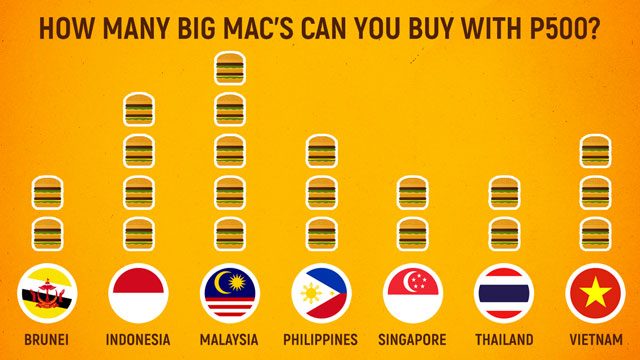SUMMARY
This is AI generated summarization, which may have errors. For context, always refer to the full article.

MANILA, Philippines – Recent months have seen the peso hit a 10-year low against the US dollar. In February, the dollar-peso exchange rate stood at P50.25 to the dollar, with the most recent figure at P49.8 to the dollar, according to the Bangko Sentral ng Pilipinas.
But what might this look like to the average consumer?
For starters, we could take a look at a McDonald’s Big Mac, an item available in every McDonald’s store worldwide. Aside from being a global favorite, the staple fast-food item is also a tool used to measure the purchasing power of a country’s currency.

Using local prices collected from the Big Mac Index and converting this into its peso-equivalent, a Big Mac would cost the most in Brunei, where one would have to pay about P245 for a single burger.
Next to Brunei, a Big Mac would cost the most in Singapore where the treat is almost P200.
In Thailand, one would have to pay P172, whereas if one were in Indonesia, it would cost about P115 to buy the item.
A Big Mac is roughly the same price in Vietnam as it is in the Philippines, where the burger goes for P132 and P133, respectively.
The McDonald’s staple is cheapest in Malaysia where a single order costs around P90.
The iconic golden arches of McDonald’s has yet to set up shop in Cambodia, Lao PDR, and Myanmar.
Burger and PPP
Introduced in 1986, The Economist started the “Big Mac Index” as an informal or even humorous tool that provides a tangible measure of purchasing power parity (PPP). PPP is tool used to compare different countries’ currencies through an identical basket of goods—in this case, a Big Mac.
But why a Big Mac?
The burger was chosen as a tool of measurement as it is an item available in all McDonald’s stores worldwide. With the brand’s commitment to consistency, this means that the same item, which consists of the same ingredients, is made the same way – all in different economies.

As a consumer, the Big Mac Index can be a nifty tool to measure just how far your money will go for in other countries.
P500 would get 5 single orders of Big Mac’s in Malaysia, the most in any ASEAN country.
Meanwhile, the same amount of money would get you two burgers in Brunei, Thailand, and Singapore – half the order, but with some change to spare.
Equal cost?
Assuming the cost of a Big Mac is the equal in different countries, the exhange rate between the peso and one Brunei dollar should be 0.053; however, the current exchange rate is 0.028. This means that the Brunei dollar is overvalued against the Philippine peso as Bruneians pay less for the burger compared to Filipinos.
But setting exhange rates aside, who could afford more Big Mac’s, Filipinos or Bruneians?
Though no law mandates a minimum wage in Brunei, according to the United States’ department Country Reports on Human Rights, the average monthly income for the private sector in Brunei is BND$ 1830. With this figure, Bruneians can buy about 256 Big Mac’s a month.
On the other hand, with the monthly minimum wage, according to the Department of Finance, at P12,488 in the National Capital Region, Filipinos would only be able to buy about 93 Big Mac’s a month.
Conversely, although a Big Mac costs the least in Malaysia at P90, with Malaysian minimum wage at MYR1000 a month, Malaysians themselves could buy up to 125 Big Mac’s.
In truth, although a Big Mac may cost the most in Brunei, Bruneians themselves would still be able to purchase the most number of burgers.
And although the item may cost the least in Malaysia, Malaysians would still be able to purchase more burgers than Filipinos with their monthly income.
Alternative to market rates
The Big Mac Index uses the burger as a staple item that takes the place of what would be an “identical baskets of goods.” This is possible because the burger can be considered an indicator of the different cost of inputs taken from a wide range of sectors: from agriculture, which includes raw materials such as beef, tomatoes, lettuce, etc. to make the burger; to advertising and service fees, labor, rent and real estate, and other costs that would go into marketing and selling the item.
With the Big Mac used to measure PPP, The Economist mentions the index is done based on the theory that “in the long run, exchange rates should eventually adjust to make the price of an identical basket of goods, the same in each country.”
PPP is often used as an alternative to market exchange rates as its equalizes the purchasing power of two different currencies by accounting for differences in inflation, cost of living, spending habits, etc. in different economies.
This means that with PPP, currencies can be compared on a more leveled field. Overvaluation or undervaluation of different countries’ currencies can be observed against a benchmark item, which in this case is a McDonald’s Big Mac. In effect, an arguably more accurate picture of a currency’s purchasing power is revealed. -Rappler.com
Add a comment
How does this make you feel?
There are no comments yet. Add your comment to start the conversation.